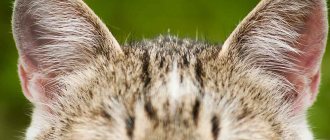Many people believe that cats never get sick. If the fluffy beauty is sad, then you need to let her go for a walk in the countryside, she will find medicinal herbs and recover. Unfortunately, not everything is so rosy. There are a number of diseases that cannot be overcome without an experienced veterinarian. Moreover, some of them are incurable. Among them is asthma. It also happens in cats, and in this case, the owners can only carry out supportive therapy and prevent the condition from worsening.
Causes
There is no answer to this question today. Why asthma in cats develops, all other things being equal, only in a part of animals - this remains to be studied. But we can say for sure that the nature of the disease is allergic. The decisive factor is genetic predisposition. This is why pathology develops and progresses in some animals, while in others it does not.
Practical observations allowed doctors to understand that asthma in cats is not tied to gender or age. Representatives of the Siamese and Himalayan breeds are more susceptible to the disease than others. It is no secret that asthma has its own catalysts, which trigger the entire mechanism.
Diagnostics
It is very difficult to determine the presence of asthma outside of an attack. Diagnosis of the disease includes a comprehensive examination of the animal:
- blood analysis;
- examination of stool and urine;
- chest x-ray.
Given the fact that many diseases may have symptoms similar to asthma, differential diagnosis is required. To make an accurate diagnosis, it is necessary to exclude a number of diseases:
- heart failure;
- pneumonia;
- oncological neoplasm in the lungs or bronchi;
- bronchitis;
- infectious diseases of the upper respiratory system.
In cats, asthma almost always occurs due to allergic reactions. Appropriate allergy tests can be carried out to determine the irritating substance.
Causes of asthma in cats
In principle, any contamination can become a predisposing factor. Reasons include:
- dust (at home you need to do wet cleaning regularly);
- any air pollution associated with the activities of factories or your personal;
- plant pollen;
- chemical fumes;
- respiratory infections.
It is almost impossible to exclude all provoking factors, neither in winter nor in summer. We can only reduce their effect to a minimum. There are a number of preventive measures for this, which we will discuss below. Regarding treatment, you must contact a specialist, undergo examination and take medications.
How do they manifest themselves?
If you know how this disease manifests itself in people, then you can easily diagnose it in our smaller brothers. The difference is not too big. The attack is characterized by bronchospasm and shortness of breath on exhalation. This is expressed in difficulty breathing, which is accompanied by wheezing. Symptoms of asthma in cats usually develop rapidly. The animal had just been playing calmly when suddenly a cough appeared. One gets the complete impression that something got into his throat.
If you are sure that your pet has not eaten anything, then you should not try to open its mouth and remove a foreign object. By doing this you will scare the animal even more. Usually the cat sits down and begins to take intermittent inhalations and exhalations. This is what an asthma attack looks like in a cat. This is quite scary, but the owner needs to control himself, otherwise he will not be able to help his pet.
Description of the disease
Bronchial asthma is a chronic inflammatory disease of the airways. Constriction of the bronchi occurs due to an allergic mechanism; an infectious nature may be a secondary factor. An asthma attack is a bronchospasm that makes breathing difficult. In this case, the walls of the bronchi thicken, the diaphragm stretches, mucus is formed abundantly, the mucous membrane swells, and an inflammatory process occurs.
Asthma is also an allergic disease in which repeated attacks of suffocation result from bronchospasm and swelling of the mucous membrane. The disease is based on the body's increased sensitivity to numerous allergens (allergies). It is believed that feline asthma is only allergic in nature. When the amount of allergen in the body goes off scale, attacks occur.
There are several degrees of severity of the disease:
- moderate – cough and wheezing are rare;
- moderate-severe – cough occurs every day, up to suffocation;
- acute severe - respiratory failure occurs, lips turn blue, bronchi narrow.
What should you be wary of?
If an attack always manifests itself very clearly, and it is almost impossible not to pay attention to it, then a number of other symptoms often escape the owner’s attention. Bronchial asthma in cats does not go away on its own, so you should pay close attention to your pet if:
- the cat gets tired quickly (usually they have enough energy for long hours of play);
- when breathing you hear whistling sounds;
- breathing is frequent and shallow;
- the back is hunched, and the neck is always elongated when sitting.
Remember that your job is to point out that something is wrong with your pet. After this, you need to urgently go to the veterinary clinic. You cannot make a diagnosis yourself based on the listed symptoms.
Symptoms
As a rule, asthma manifests itself in cats from 2 years of age (rarely at an earlier age) with heavy breathing and coughing, and decreased activity. Symptoms can be variable, and may appear suddenly or go away on their own, and there may be a seasonality of manifestations. Cough in feline asthma may worsen with age or may be paroxysmal. Symptoms can occur with varying frequency and severity - from daily severe attacks of respiratory failure, to rare episodes 2-3 times a year. Without treatment, attacks often tend to become more severe or more frequent.
Deterioration of condition
While mild wheezing when breathing can be tolerated for a while, there are symptoms that require immediate action. It is best to call an emergency veterinarian. Asthma can be difficult to accurately diagnose because symptoms can be similar to heart and lung failure. The worst thing is when breathing is so difficult that oxygen starvation occurs. The cat falls to the floor and does not react to its owner. The mucous membranes acquire a bluish tint. Usually the animal lies motionless and breathes heavily. As the condition worsens, apathy and drowsiness increase. You can’t wait, because what will happen next is the death of your pet.
Danger of disease
The disease is dangerous not only for the cat, but also for its owner. In the latter case, the stress factor plays a big role, so it is better to familiarize yourself with the possible consequences in advance.
For the cat himself
Developing hypersensitivity of the lungs is fraught with decreased immunity. In addition to an increase in bronchospasms and an increase in the amount of mucus secreted that can clog the airways, there is a high likelihood of secondary infections.
A prolonged cough makes breathing difficult, which leads to oxygen starvation. This affects the functionality of all internal organs. At a severe stage of the disease, there is an acute lack of oxygen, which can be fatal.
Stress factor for humans
The disease is not dangerous to humans, but can cause a serious blow to the psyche. Watching the daily suffering of your beloved pet is very difficult. During treatment, owners may need to take sedatives.
The situation is especially difficult for young children. A mandatory conversation should be held with the child, explaining the situation. The disease cannot be completely cured, but it can and should be kept under control. For this purpose, special medications and preventive measures are used to alleviate the condition of the sick animal.
Don't panic!
Treatment of bronchial asthma in cats is not a matter of one day. Usually it comes down to a series of supportive procedures that help avoid an attack or mitigate it. And first of all, the owner needs to calm down. The attack looks very ominous, and the animal itself is frightened, because it loses the ability to breathe. Some begin to rush about, others simply fall into a state of stupor.
Your task is to calm the animal. Do not try to catch and hold him by force, just block his exit to the street. Remember that at the moment the pet is feeling severe discomfort. He is scared and weakened, and you can only make his condition worse.
Standard scheme
As a rule, treatment of asthma in cats is strictly individual. Therefore, it is very difficult to name drugs that would help all animals with similar symptoms. Standard schemes work very poorly here. Usually the doctor prescribes a special spray that quickly relieves symptoms. This is an emergency treatment, after which a long-term therapy regimen will be prescribed.
For this purpose, hormonal drugs are selected. Most often glucocorticosteroids. If there is additionally bacterial inflammation of the bronchi, then antibiotics are prescribed. The doctor definitely recommends vitamins E and C. In general, treatment has several goals. It is necessary to relieve inflammation, reduce hypersecretion and swelling of the bronchi.
To do this, drugs from the following groups are individually selected:
- "Fluticasone propionate" - for inhalation.
- "Prednisolone" - for injection.
- Methylprednisolone tablets.
- Bronchodilators - to relieve bronchospasm.
Of course, only a qualified specialist can prescribe them. Self-medication can only worsen the animal’s condition. In pharmacies today there are quite a few analogues of these drugs, each of which has its own pros and cons. Price is not an indicator at all, so wait for a consultation with a specialist before starting treatment.
Adjuvant therapy
Traditional methods can also be used against the background of the main treatment. It is impossible to cure asthma with them, but practice allows us to judge the improvement of the condition while taking them. The pet is given decoctions of sedatives that help avoid stress and improve the general condition of the animal. If you have not examined your cat for helminthic infestations for a long time, then you can try antiparasitic decoctions of wormwood, cloves or tansy. If asthma is the result of parasites, then this will definitely help.
Prevention
This is a complex, systemic disease, so be prepared to learn to live with it. In order to prevent the condition from worsening and minimize asthmatic manifestations, it is necessary to protect your pet from the influence of the allergen. Most often this is dust and pollen, so you will have to part with some of your house plants. Factors such as household chemicals, cosmetics and perfumes, hygiene products and cat litter cannot be excluded. You especially need to pay attention to this if an adult cat suddenly gets sick. Evaluate what has changed recently: changed the wallpaper, bought new shampoo or perfume. It is at this moment that the search for an allergen can yield results.
Cleanliness is the key to health
Treatment of bronchial asthma in cats should be comprehensive. This is one of those ailments in which the main thing is to prevent the condition from getting worse. Your home should be perfectly clean. Hard-to-reach places also need wet cleaning. While you are doing the work, you need to isolate the cat so that it does not breathe in dust.
There are a number of other measures that can reduce the likelihood of an attack:
- ventilate the room more often;
- buy a humidifier;
- stop smoking in the apartment;
- adjust your pet’s diet, the cat should not be overweight;
- the litter should always be dry and clean, but washing it with modern powders is not recommended;
- Avoid stressful situations, they can worsen the animal’s condition.
Therefore, if your cat begins to have seizures, then give up loud music and visits from guests for a while. Peace and quiet can speed up recovery. During the remission stage, you need to follow the doctor’s recommendations, this will make the treatment more effective. Symptoms of asthma in a cat will appear rarely and will not interfere with life too much.
Treatment method and prognosis
Treatment depends on the severity of the disease and is aimed at creating certain conditions for long-term remission. Unfortunately, asthma cannot be cured, but it is possible to establish control over the animal’s condition and prevent the appearance of dangerous symptoms.
Therapy consists of eliminating the cause that caused the attack; if tobacco smoke is tobacco smoke, smoking is prohibited in the apartment where the cat is kept. If the allergic reaction is caused by dust, pollen, mold, provoking factors must be excluded.
Long-term treatment with glucocorticosteroids that relieve inflammation in the lungs is indicated. Veterinarians consider Prednisolone to be the most effective treatment.
To stop attacks, drugs that dilate the bronchi are used. For inflammatory processes of a bacterial nature, a course of antibiotic therapy is indicated.
Allergic symptoms are relieved with antihistamines.
For continuous use, you will need to purchase a special inhaler for animals. The veterinarian will advise what products should be used. As a rule, bronchodilators are used (Klenbyterol, Fenoterol, Albuterol, etc.).
For inhalations, experts recommend AeroKat spacers. This is a camera with a mask that is applied to the cat's face. The chamber contains the drug in the form of an aerosol. Through inhalation, the animal receives the necessary dose of medicine, with the help of which it is able to breathe.
Regular use of inhalers allows your pet to live a full life for a long time.
In addition, it is necessary to use vitamins C and E as antioxidants.










